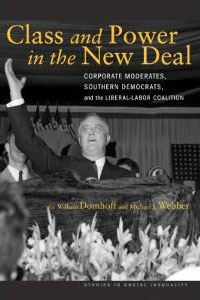Class and Power in the New Deal
Corporate Moderates, Southern Democrats, and the Liberal-Labor Coalition

A new book by G. William Domhoff and Michael J. Webber (Stanford University Press, 2011). Available from Amazon.com and many other booksellers.
Class and Power in the New Deal provides a new perspective on the origins and implementation of the three most important policies that emerged during the New Deal -- the Agricultural Adjustment Act, the National Labor Relations Act, and the Social Security Act. It reveals how Northern corporate moderates, representing some of the largest fortunes and biggest companies of that era, proposed all three major initiatives and explores why there were no viable alternatives put forward by the opposition.
More generally, this book analyzes the seeming paradox of policy support and political opposition. The authors seek to demonstrate the superiority of class dominance theory over other perspectives -- historical institutionalism, Marxism, and protest-disruption theory -- in explaining the origins and development of these three policy initiatives. Domhoff and Webber draw on extensive new archival research to develop a fresh interpretation of this seminal period of American government and social policy development.
Praise for Class and Power in the New Deal
"Domoff and Webber masterfully demonstrate how economic inequalities and the power of business and conservatives provided the unalterable terrain for those who originally conceptualized the New Deal. Using archival collections, the authors decisively resolve previous controversies and offer fresh insights about the impasse of the welfare state and American liberalism."
— Clarence Y.H. Lo, University of Missouri "In this insightful and well-written book, Domhoff and Webber revisit the sometimes acrimonious debates about the origins of New Deal policies and provide extensive evidence that powerful corporate leaders played a major role in agricultural policy, the National Labor Relations Act and the Social Security Act of 1935. Class and Power in the New Deal provides a welcome refresher course on how the 'ownership class' shaped major political decisions during the New Deal and beyond."
— Jill Quadagno, Florida State University "Drawing on newly available archival evidence, Domhoff and Webber investigate the origins and trajectories of three main policy pillars of the New Deal -- the Agricultural Adjustment Act, the National Labor Relations Act, and the Social Security Act. Their account challenges existing approaches and proves that their class-domination theory is a bruising contender in explanations of American policy."
— Jeff Manza, New York University |

 mobile/printable version of this page
mobile/printable version of this page